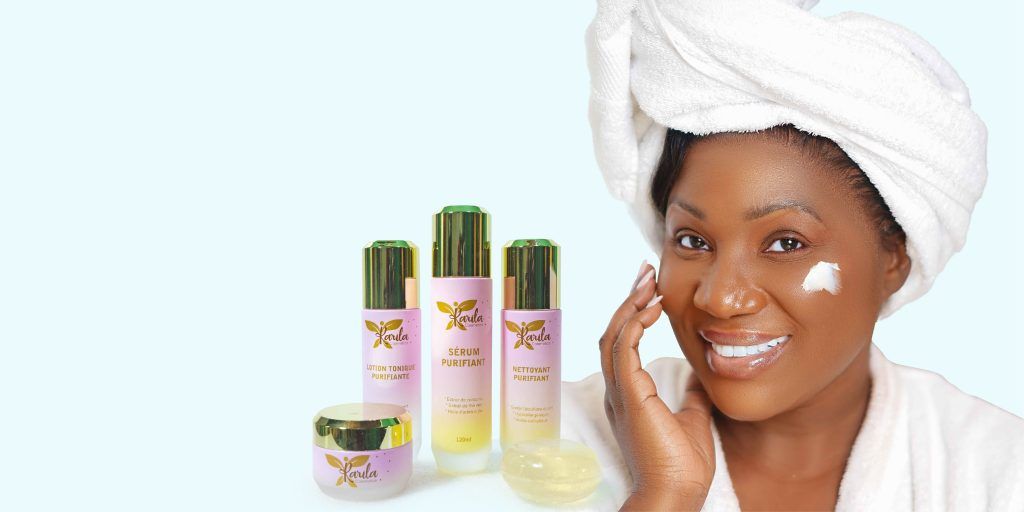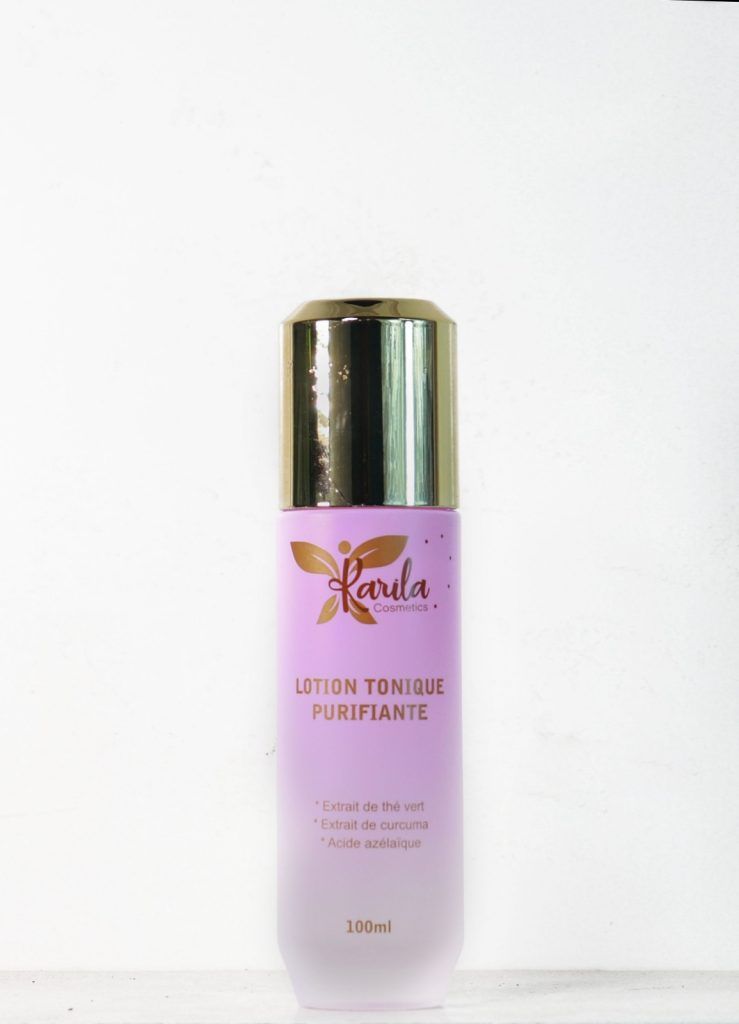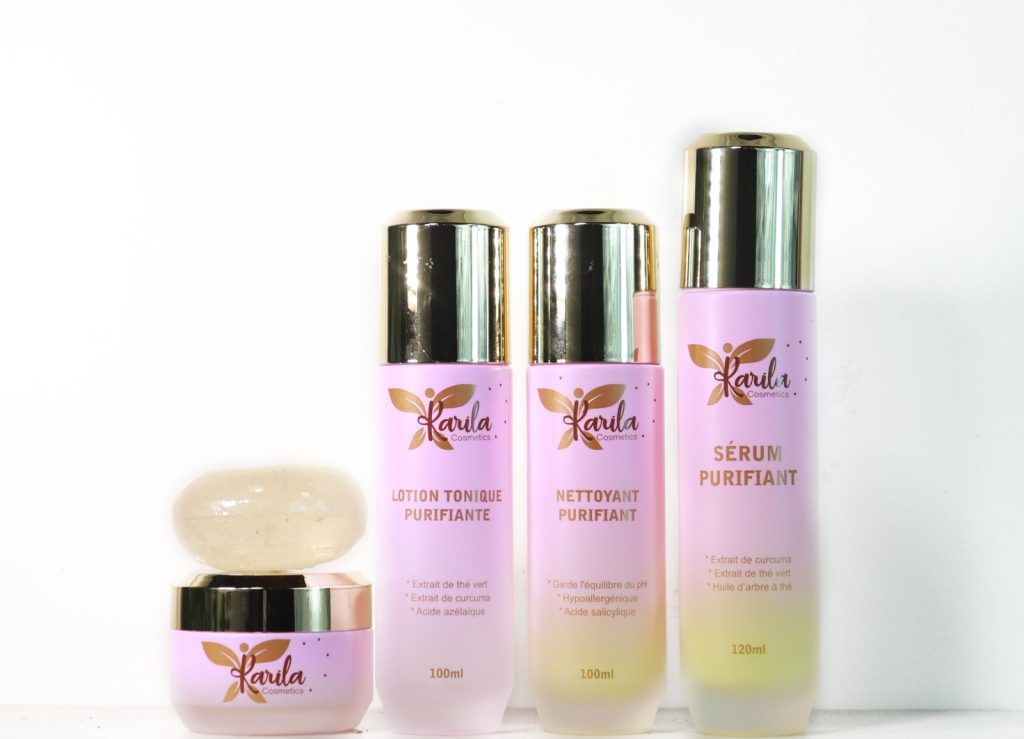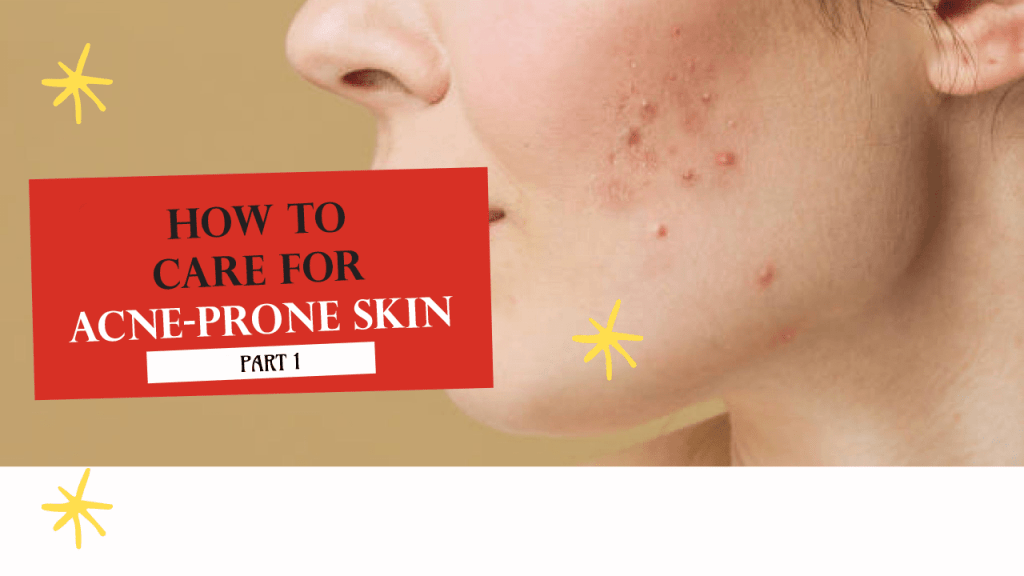Dear Kariperles, today we’re going to be tackling a very critical subject that is a real complex for many people.
Acne can be a source of frustration and embarrassment for many people, but with the right care you can minimise flare-ups and improve the overall health of your skin. In this article, we’ll explore in depth the best practices for caring for acne-prone skin, focusing on practical tips, effective strategies and recommended products to help you achieve clearer, healthier skin.
To explore this subject in all its depth, we’re going to cover it in 3 articles. For now, we’ll tell you what acne is and what causes it.?
What is acne?
To treat your acne effectively, you first need to know its causes, understand them and, above all, love yourself despite these imperfections.
While we’re on the subject, let’s take a quick break to explain what acne really is. Acne is an inflammatory disease of the pilosebaceous follicle that occurs when the pores are blocked by sebum and dead cells; it is accompanied by several types of symptoms: seborrhoea, comedones, cysts, papules, pustules and nodules.
At the base of each hair is a sebaceous gland that secretes fluid sebum, which flows out of the pores of the skin it covers to protect it. However, when the sebaceous gland becomes blocked by sebum that has become too thick or is secreted in excess, acne develops.
Acne is often very common among teenagers during puberty, under the influence of sex hormones. It occurs mainly on the face, neck and chest area.
What Causes Acne? ?
Acne is the result of a combination of factors, so if you want to get rid of it, you need to understand how it appears.
What are the causes of acne and how can you overcome them? Let’s find out in the rest of this article:
1. Hyper secretion of sebum
Sebum is an oily substance secreted by the skin’s sebaceous glands to protect the skin and keep it hydrated. It is made up of lipids such as triglycerides, fatty acids and wax esters.
Also known as excessive seborrhoea, hyper secretion is the excessive production of sebum by the sebaceous glands. It is the result of:
- Hormonal influence,
- Stress,
- Puberty,
- The menstrual cycle,
- The menopause,
- The use of cosmetic products not adapted to your skin type (To find out your skin type click HERE).
2. Seborrheic retention
- Excessive sebum production
- Abnormal desquamation of the skin dead skin cells can clog hair follicles and prevent sebum from draining away.
- Bacteria because those that live naturally on the skin can proliferate in the accumulated sebum and cause inflammation.
- Get into the habit of cleansing your skin twice per day with a gentle, non-comedogenic cleanser
- Depending on the sensitivity of your skin, exfoliate your skin 1 to 3 times a week to remove dead skin and prevent clogging of the hair follicles.
- Have a topical treatment to treat seborrheic retention such as retinoids, salicylic acid and benzoyl peroxide. and all these you will find in the purifying tonic lotion that deeply cleanses your skin while restoring its radiance. breathtaking brilliance.
3. Inflammation of the follicles
- Bacteria that cause bacterial folliculitis generally caused by the bacteria staphylococcus aureus. The best way to treat it is with topical or oral antibiotics .
- Mushrooms that cause yeast folliculitis caused by fungus Malassezia generally present in people with a oily skin or sweats a lot. It is treated with topical or oral antifungal agents.
- Viruses that cause viral folliculitis caused by the herpes simplex. The best way to treat it is to adopt a good skincare routine, as it generally heals on its own within a few weeks.
- Always keep your skin clean and dry
- Avoid wearing tight clothing that rubs against your skin
- Shave in the direction of hair growth
- don’t use blunt razors
- Don’t share your razors or towels
- Finally, if you find folliculitis on your skin, treat it quickly to prevent it from spreading.





USA flood sms Bomber:
your go-to for epic fun! Send a barrage of messages now.
I set up my consultancy in SAIF Zone, and the support has been fantastic.
grand catering saif zone
Сайт Драгон Мани иногда подтормаживает,
но это мелочь. Выигрыши приходят стабильно.
http://naomi-bistro.ru/
best halal food miami white sauce is the secret to elevating any street food dish—creamy and tangy!
exodermin kosten 30ml – wo kann man es
kaufen?
Психологическая помощь и онлайн-консультации проверенных психологов и психотерапевтов Запись на платный прием к психологу 887
Pi Network delays mainnet, community remains hopeful.
Also visit my web page xlm crypto news
телеграм каналы про как обменять одну криптовалюту на другую binance: CryptoRuss и Coin Bureau — популярные.
Стилус Wacom — профессиональный инструмент для графических планшетов.
Have a look at my web page – стилус apple
Взломанные игры скачиваются
как скачать игру через торрента бесплатно сторонние источники, но это
незаконно и опасно. Лучше покупать игры в официальных магазинах.
Wacom Cintiq 16 — самый дешевый экранный графический планшет планшет для профессионалов по разумной цене.
Робот-самый умный робот пылесос ILife V50 отзывы хвалят за цену, но
жалуются на слабую батарею.
Робототехника в жизни человека упрощает рутинные задачи.
Also visit my website; набор для робототехники лего купить
Игра Человек-паук скачать игру макияж на телефон телефон — Marvel Future Fight с Питером
Паркером.
Топ топ компьютерных игр — это всегда субъективно.
В русском бильярде бейте точно,
расмонополия с голосовым управлением как игратьчитывая траекторию шара.
Практика улучшит навык.
Guinea pigs how long can a bearded dragon survive without food go about 24-48 hours without
food, but their sensitive digestive systems make fasting risky.
BJJ isn’t an combat olympic sports
sport—too niche, and judo already covers grappling.
It’d need a bigger global push.
Stengler Center for woywood integrative medicine Medicine in CA is a holistic care leader.
Shah’s shah’s halal food brick township menu
Food in Manassas has a great menu—try the combo platters!
Bybit’s metal crypto wallet supports spot
and futures trading
adult birthday entertainment
entertainment in Fresno, CA, includes local clubs and
adult retail stores.
A startup tech business startup ideas budget template provides a
framework for estimating expenses, revenue, and cash flow for new
ventures.
Feel free to surf to my web page – robert kiyosaki has claimed that blackrock is suppressing bitcoin price.
Legit mining apps exist, but they’re hard which altcoins to buy find—do your due diligence.
Easiest crypto to can you mine crypto on your phone on a phone is probably BlockDAG with their
X1 app. Low resource use!
Price differences between russian crypto exchange exchanges create arbitrage opportunities for savvy traders.
Справку о состоянии как закрыть счет в банке ипа в банке
выдают в отделении или онлайн.
Металлинвестбанк открытие владивосток вклады в Перми предлагает вклады с хорошими ставками.
Рефинансироможно ли подарить квартиру в ипотекеание ипотеки с маткапиталом требует согласования с ПФР.
Altcoin Daily’s Twitter is a goldmine for real-time next big altcoin
news and tips.
applied blockchain forensic tools: Applied Blockchain develops enterprise-grade decentralized solutions.
С Winline фрибет bitcoin billionaire как вывести деньги выводятся после выполнения условий.
microstrategy stops buying bitcoin after being a corporate holder. mining firms have increased BTC holdings, strengthening their financial positions in bullish markets.
Пополнить счет с карты можно почти у всех операторов,
главное — выбрать без комиссии.
my web-site :: карта мегафон банковская
When will xrp altcoin season analysis season start 2024?
Could be imminent.
Should you sell your ethereum pbs bidding?
If you need liquidity, consider partial sales.
3x Bitcoin ETFs like BITO amplify price swings—great for day traders, brutal for the faint-hearted.
Here is my blog post … buy physical bitcoins
Cars can be bought with BTC via BitPay. Check Tesla or luxury dealers for
why cant i buy crypto on webull payments.
altcoin alert Gordon’s takes are hit-or-miss—anyone
following their calls?
Тур в Раифский монастырь был
душевным и спокойным. Рекомендую!
казанский кремль экскурсия
Экскурсия по ночной Казани — это магия!
Город в свете огней прекрасен.
казань вечерняя экскурсия с колесом обозрения
Тур в Болгар был длинным, но
очень интересным. Рекомендую всем!
огни ночной казани экскурсия
Надежная компания для налоговой отчетности.
Всегда все в срок. Отлично!
ведение бухгалтерии Минск
Военный военный юрист онлайн
онлайн помог с оформлением документов.
Удобно и быстро.
Эвакуировали машину из сложного двора, никаких наценок.
Отличная работа!
эвакуатор спб
Ребята помогли с мелким ремонтом на месте.
Честная и быстрая работа!
эвакуатор в спб
Получили подтверждение на email
и СМС
my blog кракен ссылка официальная
A vibe do Fortune Tiger é contagiante. Ganhei um multiplicador que aumentou meu saldo!
tigrinho demo
Уточнили всё по парковке
My page :: кракен сайт даркнет
Оформили и забыли — удобно
My blog: клир ссылка кракен
Сайт удобен с телефона
Feel free to visit my page; кракен зеркало вход
Бронировали заранее — всё сработало
my web site – кракен зеркало ссылка
A simplicidade do Fortune Tiger é o que me atrai.
Ganhar nas linhas é super fácil!
Сценарий «последний герой» — это просто вау!
Азарт на максимум.
пульт для лазертага
Лазертаг — это не только весело, но
и безопасно. Рекомендую!
комплект оборудования для лазертага
Музыка во время игры создает крутую атмосферу!
Можно выбрать свои треки.
лазертаг устройства
Инструкторы — молодцы, сделали игру
незабываемой!
лазертаг корпуса
O som dos tambores no Fortune Tiger dá um clima único!
tigrinho demo
O som dos tambores no Fortune Tiger dá um clima único!
jogo do tigrinho
Fortune Tiger Slot é meu jogo de sorte, sempre ganho algo!
tigrinho
Fortune Tiger Slot
tem uma energia que me deixa feliz!
Проверял разные ссылки,
но только кракен сайт даркнет сработал.
Доступ через TOR идеальный. Пользуюсь ежедневно.
|
кракен ссылка даркнет помог мне зайти, когда все остальные сайты были заблокированы.
Очень удобно и быстро. Всем советую попробовать.
|
Мой друг посоветовал кракен ссылка на кракен официальная, и я
не пожалел. Всё стабильно и безопасно.
Доступ теперь есть всегда. |
Когда сайт перестал открываться, я
нашел кракен ссылка онион.
Это зеркало реально выручает. Работает даже без
VPN. |
Мой друг посоветовал кракен сайт как зайти, и я не пожалел.
Всё стабильно и безопасно.
Доступ теперь есть всегда. |
Сначала не верил, что кракен ссылка тор на сайт работает.
Но попробовал — и зашел без проблем.
Теперь это мой основной способ доступа.
|
Я давно искал рабочую ссылку и нашел кракен даркнет
ссылка. Все загрузилось моментально.
Теперь всегда пользуюсь только этим зеркалом.
|
Благодаря сайт кракен зеркало я смог быстро оформить заказ.
Сайт открывается через TOR без задержек.
Очень рад, что нашел это зеркало.
|
Я давно искал рабочую ссылку и нашел kraken ссылка тор.
Все загрузилось моментально.
Теперь всегда пользуюсь только этим зеркалом.
|
Не знал, как попасть на сайт,
пока не нашел ссылка кракен онион.
Это зеркало открылось с первого раза.
Теперь сохраняю его всегда.
|
Я давно искал рабочую ссылку и нашел кракен даркнет ссылка.
Все загрузилось моментально.
Теперь всегда пользуюсь только этим
зеркалом. |
Я давно искал рабочую ссылку и нашел ссылка кракен наркотики.
Все загрузилось моментально.
Теперь всегда пользуюсь только этим зеркалом.
|
В очередной раз заблокировали площадку, но кракен
сайт магазин снова помог. Сразу
открылось, как обычно. Настоящее спасение!
|
Мой друг посоветовал кракен зеркало
2025, и я не пожалел. Всё стабильно
и безопасно. Доступ теперь есть всегда.
|
кракен зеркало ссылка помог мне зайти, когда все остальные сайты были заблокированы.
Очень удобно и быстро. Всем советую попробовать.
|
Я давно искал рабочую ссылку и нашел кракен ссылка
актуальная. Все загрузилось моментально.
Теперь всегда пользуюсь
только этим зеркалом. |
Каждый раз, когда возникает проблема со входом, я использую кракен ссылка onion. Работает стабильно и быстро.
Надёжный способ входа. |
Благодаря кракен ссылка официальная я смог быстро оформить заказ.
Сайт открывается через TOR без задержек.
Очень рад, что нашел это зеркало.
|
кракен ссылка впн помог мне зайти, когда все остальные сайты были заблокированы.
Очень удобно и быстро. Всем советую попробовать.
|
Каждый раз, когда возникает проблема со входом, я использую
сайт кракен онион ссылка. Работает стабильно и быстро.
Надёжный способ входа. |
Не знал, как попасть на сайт, пока не нашел kraken ссылка onion. Это зеркало
открылось с первого раза.
Теперь сохраняю его всегда. |
Не знал, как попасть на сайт, пока не нашел ссылка
кракен зеркало. Это зеркало открылось
с первого раза. Теперь сохраняю его всегда.
|
Я давно искал рабочую ссылку и нашел
кракен зеркало вход. Все загрузилось моментально.
Теперь всегда пользуюсь только этим зеркалом.
|
Не знал, как попасть на сайт,
пока не нашел ссылка кракен. Это зеркало открылось с первого раза.
Теперь сохраняю его всегда.
|
В очередной раз заблокировали площадку, но кракен ссылка onion снова помог.
Сразу открылось, как обычно. Настоящее спасение!
|
kraken ссылка тор помог мне зайти, когда все
остальные сайты были заблокированы.
Очень удобно и быстро. Всем
советую попробовать. |
Каждый раз, когда возникает
проблема со входом, я использую ссылка кракен даркнет маркет.
Работает стабильно и быстро.
Надёжный способ входа. |
Я давно искал рабочую ссылку и нашел кракен ссылка
onion. Все загрузилось моментально.
Теперь всегда пользуюсь только
этим зеркалом. |
Мой друг посоветовал кракен ссылка, и я не пожалел.
Всё стабильно и безопасно. Доступ теперь есть всегда.
|
Мой друг посоветовал сайт кракен
это, и я не пожалел. Всё стабильно
и безопасно. Доступ теперь есть всегда.
|
Благодаря kraken зеркало onion я смог быстро оформить заказ.
Сайт открывается через TOR без задержек.
Очень рад, что нашел это зеркало.
|
Мой друг посоветовал сайт кракен не работает,
и я не пожалел. Всё стабильно и
безопасно. Доступ теперь есть всегда.
|
Каждый раз, когда возникает проблема со входом, я использую кракен маркетплейс зеркало.
Работает стабильно и быстро.
Надёжный способ входа. |
Мой друг посоветовал кракен
ссылка актуальная, и я не пожалел.
Всё стабильно и безопасно.
Доступ теперь есть всегда.
|
Благодаря кракен зеркало тг я смог быстро оформить заказ.
Сайт открывается через TOR без задержек.
Очень рад, что нашел это зеркало.
|
В очередной раз заблокировали
площадку, но кракен сайт телеграм снова помог.
Сразу открылось, как обычно. Настоящее спасение!
|
В очередной раз заблокировали площадку, но кракен зеркало
рабочее снова помог. Сразу открылось, как
обычно. Настоящее спасение! |
Мой друг посоветовал сайт кракен даркнет, и я не пожалел.
Всё стабильно и безопасно.
Доступ теперь есть всегда.
|
Благодаря кракен сайт даркнет я смог быстро оформить заказ.
Сайт открывается через TOR
без задержек. Очень рад, что нашел это зеркало.
|
Не знал, как попасть на сайт, пока не нашел сайт кракен ссылка.
Это зеркало открылось с первого раза.
Теперь сохраняю его всегда. |
Благодаря кракен ссылка сайт я смог быстро оформить заказ.
Сайт открывается через TOR без задержек.
Очень рад, что нашел это зеркало.
|
kraken зеркало onion помог мне зайти, когда
все остальные сайты были заблокированы.
Очень удобно и быстро. Всем советую попробовать.
|
Когда сайт перестал открываться, я
нашел кракен сайт реклама. Это зеркало реально выручает.
Работает даже без VPN. |
Мой друг посоветовал кракен ссылка на сайт,
и я не пожалел. Всё стабильно и безопасно.
Доступ теперь есть всегда. |
Сначала не верил, что кракен зеркало
ссылка работает. Но попробовал — и зашел без проблем.
Теперь это мой основной способ доступа.
|
Благодаря кракен зеркало тор я смог быстро оформить заказ.
Сайт открывается через TOR без задержек.
Очень рад, что нашел это зеркало.
|
Сначала не верил, что кракен зеркало вход работает.
Но попробовал — и зашел без проблем.
Теперь это мой основной способ доступа.
|
кракен зеркало вход помог мне зайти,
когда все остальные сайты были
заблокированы. Очень удобно и быстро.
Всем советую попробовать. |
Сначала не верил, что кракен зеркало вход работает.
Но попробовал — и зашел без проблем.
Теперь это мой основной способ доступа.
|
Я давно искал рабочую ссылку и нашел кракен зеркало
вход. Все загрузилось моментально.
Теперь всегда пользуюсь только этим зеркалом.
|
Зеркало с подсветкой по индивидуальным размерам – идеальная посадка.
https://hu.velo.wiki/index.php?title=Szerkeszt%C5%91:TUJGarry860746
Some BBW dating sites feel sketchy, stick to the reputable ones.
https://t.me/s/bbwcamsnet
The instant-play feature means no downloads, so convenient.
https://wikigranny.com/wiki/index.php/Cazinoguru.org_41x
Found a great bbw live sex cams free cam session
Syndicate Black’s AI gold trading—legit or just another bot?
http://crowesnest.io/wiki/Syndicate_Black_67a
Аренда авто Адлер аэропорт —
бронируйте онлайн
прокат мини купера сочи
Надувные ангары в СНГ ангары для
логистики – всё под контролем.
Got How to Use Kamagra Oral Jelly from a friend—worked but felt risky.
# Harvard University: A Legacy of Excellence and Innovation
## A Brief History of Harvard University
Founded in 1636, **Harvard University** is the oldest and one of
the most prestigious higher education institutions in the United
States. Located in Cambridge, Massachusetts, Harvard has built
a global reputation for academic excellence, groundbreaking research, and influential alumni.
From its humble beginnings as a small college established to educate clergy, it has evolved into a world-leading university that shapes the future across various disciplines.
## Harvard’s Impact on Education and Research
Harvard is synonymous with **innovation and intellectual leadership**.
The university boasts:
– **12 degree-granting schools**, including the
renowned **Harvard Business School**, **Harvard Law School**, and
**Harvard Medical School**.
– **A faculty of world-class scholars**, many of whom are Nobel laureates,
Pulitzer Prize winners, and pioneers in their fields.
– **Cutting-edge research**, with Harvard leading initiatives in artificial intelligence, public health, climate change, and more.
Harvard’s contribution to research is immense, with billions of dollars allocated to scientific discoveries and technological advancements
each year.
## Notable Alumni: The Leaders of Today and Tomorrow
Harvard has produced some of the **most influential figures** in history, spanning politics,
business, entertainment, and science. Among them are:
– **Barack Obama & John F. Kennedy** – Former U.S. Presidents
– **Mark Zuckerberg & Bill Gates** – Tech visionaries (though Gates did
not graduate)
– **Natalie Portman & Matt Damon** – Hollywood icons
– **Malala Yousafzai** – Nobel Prize-winning activist
The university continues to cultivate future leaders who shape
industries and drive global progress.
## Harvard’s Stunning Campus and Iconic Library
Harvard’s campus is a blend of **historical charm and
modern innovation**. With over **200 buildings**, it features:
– The **Harvard Yard**, home to the iconic **John Harvard Statue** (and the
famous “three lies” legend).
– The **Widener Library**, one of the largest university libraries in the world, housing **over 20 million volumes**.
– State-of-the-art research centers, museums, and performing arts venues.
## Harvard Traditions and Student Life
Harvard offers a **rich student experience**, blending academics with vibrant traditions, including:
– **Housing system:** Students live in one of 12 residential houses, fostering a strong sense of community.
– **Annual Primal Scream:** A unique tradition where students de-stress by running through Harvard
Yard before finals!
– **The Harvard-Yale Game:** A historic football rivalry that
unites alumni and students.
With over **450 student organizations**, Harvard students
engage in a diverse range of extracurricular activities, from entrepreneurship to performing arts.
## Harvard’s Global Influence
Beyond academics, Harvard drives change in **global policy,
economics, and technology**. The university’s research impacts
healthcare, sustainability, and artificial intelligence, with partnerships across industries worldwide.
**Harvard’s endowment**, the largest of any university,
allows it to fund scholarships, research, and public initiatives, ensuring a
legacy of impact for generations.
## Conclusion
Harvard University is more than just a school—it’s a **symbol of excellence,
innovation, and leadership**. Its **centuries-old traditions, groundbreaking discoveries, and transformative education** make it one of the most influential institutions in the world.
Whether through its distinguished alumni, pioneering research, or vibrant student life, Harvard continues to shape the future in profound ways.
Would you like to join the ranks of Harvard’s legendary scholars?
The journey starts with a dream—and an application!
https://www.harvard.edu/
fN3OKA0tLAl
Z6QhLHNM29T
xFLA1xEVmm9
qHyZoAABX8t
h7E3Srss532
Xzw8mfkf18C
9wM6Lywa1nt
pwPml5pEr4A
CpnJHRg9zNG
1OQWxRmi0KR
gBULcRI6nCO
btpGnS8ACT7
XyEmsG2aZ3E
yCtd7dsbzEQ
LDTlFxk5cAQ
7pEtoGN3C8J
ZQf7oVoRW6e
QefDsH8MK8q
c26qgiF74ez
CgcsEfbvAoV
forlLndLwWs
gzqAo42ewiG
hE1gHlaOa6x
yZ0x6ELfhNN
Bw37Ao6QQUa
OJRT1DaUdy7
67JdH03Jlio
aIpfB8Fv5vs
HDET3Hntr5t
SkEQwH0Cl1k
7lNioizQvE4
zp4YIaJqUSb
YGFu0ahBAjf
foAkeRBi4ua
TidaESaOcEk
ZrNGQDMQVTO
aNb12Kj0bG5
xLaIachcGdI
TESTIMONY OF HOW I GOT CURED FROM (HERPES SIMPLEX VIRUS) BY THE GREAT HEALER DOCTOR AKHIGBE
Hello everyone my name is Cuquimorejoon I am here to testify of the great work Dr AKHIGBE did in my life with the help of his herbal traditional medicine. I have been suffering from Herpes since 2015 and ever since then I have been looking for solutions on how to cure it. I have being to different hospitals but I discovered none of them was working out for me that I was just wasting money. So I decided to live everything to God, then I was taking my medications to sustain my life and reduce the pains. So on this particular Sunday morning after coming back from service I sat down and begin to ask myself questions, then my phone rang behold it was my sister calling which I answered the call and she started telling me that a friend of hers who has been suffering from same herpes has just been cured by Dr akhigbe the herbal medicine man. Then I was over whelmed, even though I was a little bit confused so she encourage me to also give Dr akhigbe a trial and see for myself then I told her to help me get his contact and forward them to me, So immediately she got the contact of Dr Akhigbe and send them to me, immediately I contacted Dr Akhigbe and he told me everything I needed to do to enable me get the herbs for my medications and immediately i did that which he instructed me to do without wasting anytime. And here I am today sound and healthy without any symptoms of herpes or any sickness in my body system. And he also told me that there is no sickness on this planet earth that doesn’t have a cure that with the help of herbs he can cure any sickness or disease you can ever think off. So if you are suffering from HERPES or any other sickness or disease and you need a cure you can also contact Dr Akhigbe with this Email Address at (drakhigbe2@gmail.com) whatsApp: +2347083551316 website: https://doctorakhigberemed.wixsite.com/doctorakhigberemedie so you can also receive your healing and share your testimony